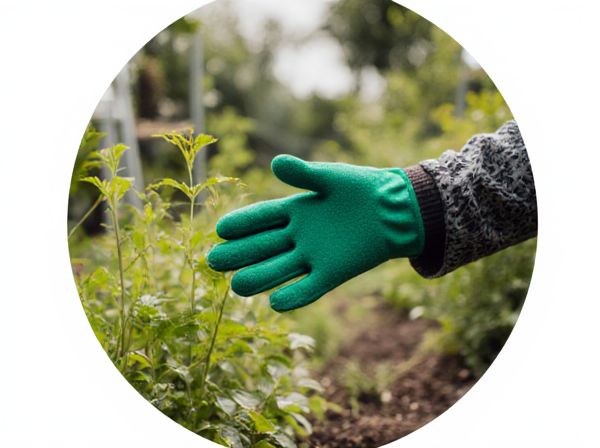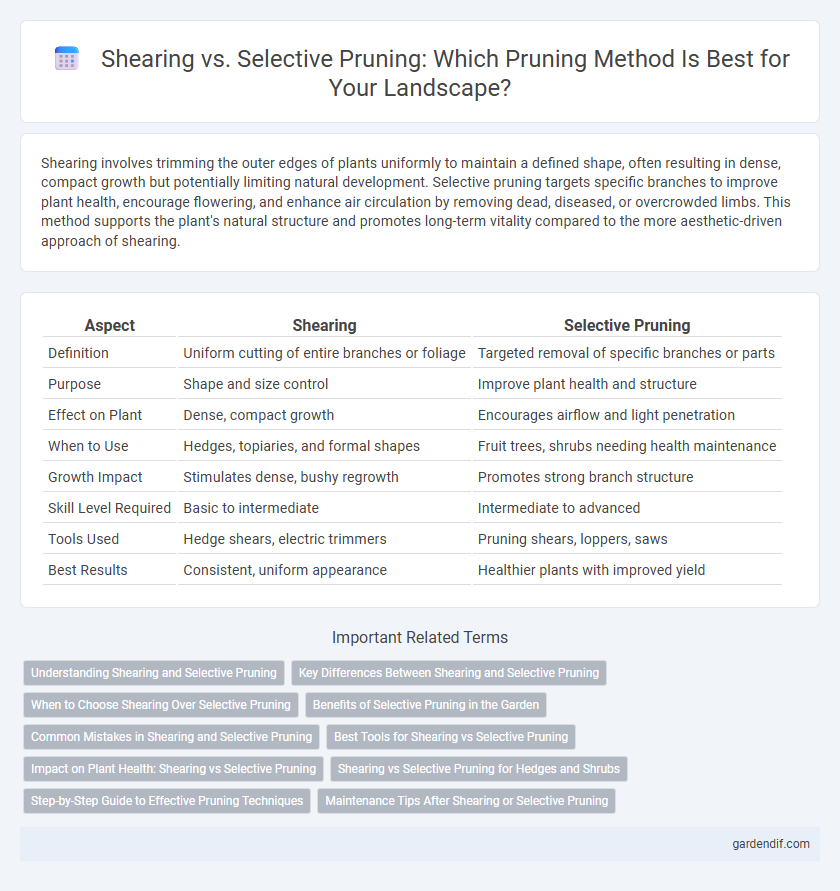
Shearing vs selective pruning Illustration
Shearing involves trimming the outer edges of plants uniformly to maintain a defined shape, often resulting in dense, compact growth but potentially limiting natural development. Selective pruning targets specific branches to improve plant health, encourage flowering, and enhance air circulation by removing dead, diseased, or overcrowded limbs. This method supports the plant's natural structure and promotes long-term vitality compared to the more aesthetic-driven approach of shearing.
Table of Comparison
| Aspect | Shearing | Selective Pruning |
|---|---|---|
| Definition | Uniform cutting of entire branches or foliage | Targeted removal of specific branches or parts |
| Purpose | Shape and size control | Improve plant health and structure |
| Effect on Plant | Dense, compact growth | Encourages airflow and light penetration |
| When to Use | Hedges, topiaries, and formal shapes | Fruit trees, shrubs needing health maintenance |
| Growth Impact | Stimulates dense, bushy regrowth | Promotes strong branch structure |
| Skill Level Required | Basic to intermediate | Intermediate to advanced |
| Tools Used | Hedge shears, electric trimmers | Pruning shears, loppers, saws |
| Best Results | Consistent, uniform appearance | Healthier plants with improved yield |
Understanding Shearing and Selective Pruning
Shearing involves uniformly trimming the outer growth of plants or shrubs to create a clean, defined shape, often used for hedges and topiaries. Selective pruning targets specific branches to remove dead, damaged, or overcrowded parts, promoting healthier growth and enhancing the plant's natural form. Understanding these techniques helps optimize plant health, aesthetics, and structural integrity.
Key Differences Between Shearing and Selective Pruning
Shearing involves trimming all outer growth uniformly to create a dense, shaped appearance, while selective pruning targets specific branches to improve plant structure, health, and airflow. Shearing often results in rapid new growth but can lead to weak inner branches, whereas selective pruning encourages strong, balanced development by removing dead or crossing limbs. Understanding these key differences helps gardeners choose between maintaining aesthetic form or enhancing plant vitality through strategic branch removal.
When to Choose Shearing Over Selective Pruning
Shearing is ideal for shaping dense hedges and maintaining uniform appearance when rapid growth requires regular trimming. Selective pruning is better for improving plant health and structure by removing specific branches, but choose shearing to promote thick foliage and precise form in shrubs like boxwoods or privet. Use shearing during the active growing season for consistent size control and aesthetic appeal in formal garden designs.
Benefits of Selective Pruning in the Garden
Selective pruning enhances plant health by removing specific branches, improving air circulation and sunlight penetration essential for growth. It promotes stronger structural development, reducing risks of disease and pest infestations compared to shearing. This careful technique also preserves the natural shape and aesthetics of garden plants, supporting biodiversity.
Common Mistakes in Shearing and Selective Pruning
Common mistakes in shearing include over-cutting, which stresses plants and leads to weak growth, and shaping without regard to natural branch structure, causing unnatural density and reduced air circulation. Selective pruning errors often involve removing too many live branches, resulting in decreased photosynthesis and overall plant health, or cutting too close to the branch collar, which hampers proper wound healing. Proper understanding of plant biology and growth patterns is essential to avoid these frequent errors in both shearing and selective pruning techniques.
Best Tools for Shearing vs Selective Pruning
Best tools for shearing include hedge trimmers and electric shears designed for shaping large bushes and formal hedges with precision and speed. Selective pruning requires hand pruners, bypass loppers, and pruning saws to carefully remove specific branches for plant health and structure. Choosing the right tool depends on the pruning goal, where shearing tools allow uniform cuts, and selective pruning tools enable more controlled and detailed branch removal.
Impact on Plant Health: Shearing vs Selective Pruning
Shearing creates a dense, uniform canopy that can restrict airflow and light penetration, increasing the risk of disease and pest infestations. Selective pruning removes specific branches to improve air circulation and sunlight exposure, promoting stronger growth and reducing stress on the plant. By targeting only unhealthy or overcrowded limbs, selective pruning enhances overall plant health and longevity more effectively than shearing.
Shearing vs Selective Pruning for Hedges and Shrubs
Shearing creates a uniform, dense appearance by trimming the outer growth of hedges and shrubs evenly, promoting a formal shape but potentially reducing air circulation and natural growth patterns. Selective pruning involves strategically removing specific branches to enhance plant health, structure, and natural form, encouraging better light penetration and air flow within the plant canopy. For hedges and shrubs, selective pruning supports long-term vigor and a more natural aesthetic, while shearing is effective for maintaining crisp, geometric lines in formal landscapes.
Step-by-Step Guide to Effective Pruning Techniques
Shearing involves trimming the outer edges of shrubs uniformly to maintain shape, while selective pruning targets specific branches to enhance plant health and growth. Begin pruning by removing dead or diseased wood, then thin out crowded branches to improve air circulation and light penetration. Focus on cutting at branch junctions and use clean, sharp tools to minimize damage and encourage vigorous regrowth.
Maintenance Tips After Shearing or Selective Pruning
Regular maintenance after shearing involves cleaning tools thoroughly to prevent disease spread and applying appropriate wound sealants to enhance healing. Selective pruning requires careful removal of dead or crowded branches while monitoring plant response to avoid stress and ensure optimal growth. Both methods benefit from timely watering and mulching to support recovery and sustain plant health.
Shearing vs selective pruning Infographic

 gardendif.com
gardendif.com